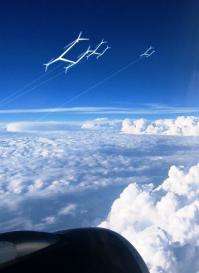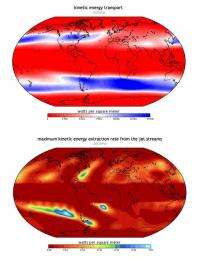The high winds of the upper atmosphere contain less renewable energy than previously assumed

It seems that the energy mix of the future will have to differ from the current suggestions of some visionaries. This is because the jet streams that sweep the upper atmosphere with high winds would yield about 200 times less energy than previously estimated, according to calculations by researchers at the Max Planck Institute for Biogeochemistry in Jena, Germany. The high winds were thought to be a rich potential source of renewable energy. However, their speed is due to the near absence of friction and not to strong propulsion, which would be necessary for high-output wind turbines. Using climate simulations, the researchers also discovered that the climate system could be subjected to massive change if large amounts of energy were taken from the jet streams.
At heights of 7 to 16 kilometres, the air in jet streams moves at constant speeds of over 25 metres per second or 90 kilometres an hour. These high speeds suggest that the winds could be used as a practically inexhaustible source of renewable energy; and extensive investments are already being made in technologies that aim to tap into that source. However, the energy of the jet streams is limited. Like other wind and weather systems on Earth, the jet streams are generated because solar radiation heats the tropics more than the polar regions. The resulting temperature differential in the atmosphere leads to a drop in air pressure, and this pressure difference is the driving force behind the wind. Consequently, the disparate warming sets the upper limit on the strength of the wind. It also determines the maximum amount of renewable wind energy that is available for extraction.
The power and direction of the jet streams arise through the accelerating effect of pressure changes in the upper atmosphere and the Coriolis force generated by the Earth’s rotation. The Coriolis force deflects winds in the northern hemisphere to the right and winds in the southern hemisphere to the left. Meteorological science has shown that the jet streams are so fast because they arise in the upper atmosphere, far from the surface of the Earth. This means that they are subjected to almost no friction; experts speak of geostrophic winds. Consequently, very little energy is required to initiate and maintain these airflows.

Jet stream energy extraction would cause massive climate change
“It is precisely this low energy requirement that limits the potential for using the jet streams as a source of renewable energy”, explains Axel Kleidon, head of the Independent Max Planck Research Group on Biospheric Theory and Modelling. Based on atmospheric energetics and using climate simulation models, Kleidon’s group has calculated the maximum rate at which wind energy can be taken from the global atmosphere. According to their estimates, the jet streams have an output of just 7.5 terawatts (one terawatt equals a million megawatts). This means that they generate 200 times less usable wind energy than stated in previous studies, and only about half of humankind’s primary energy requirements, which totalled about 17 terawatts in the year 2010.
The Max Planck researchers also studied how climate would change if the jet streams were tapped into on a large scale as a source of renewable energy. Every wind turbine establishes a resistance in order to convert wind energy into power, and the balance of forces in the jet stream is altered as soon as that energy is removed from it. If turbines were to harvest the full 7.5 terawatts contained in the jet streams, this balance would be massively altered. The pressure difference between the equatorial region and the poles would disappear, and the whole climate system would slow down. “If we used wind turbines to take 7.5 terawatts out of the atmosphere at the level of the jet streams, about 300 terawatts less energy would be generated in the atmosphere as a whole”, explains Lee Miller, lead author of the study. “This would have a drastic impact on temperature and weather.”
Too little wind energy, too much risk – it seems like these high winds will contribute less to tomorrow’s energy mix than some had hoped. “Our investigations show that the potential of the jet streams as a source of renewable energy was overestimated”, says Axel Kleidon. “It is incumbent on us to carefully study the global impact of renewable energy technologies that seem environmentally sound.”
More information: Lee M. Miller, et al., Jet stream wind power as a renewable energy resource: little power, big impacts, Earth System Dynamics, 29 November 2011; doi: 10.5194/esd-2-201-2011
Provided by Max-Planck-Gesellschaft


















